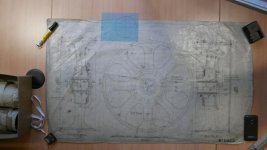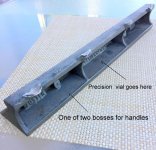dazz
Stainless
- Joined
- Aug 20, 2006
- Location
- New Zealand
Hi
I am investigating the feasibility of building a miniature 1/3 scale 1925 Steam Wagon.
I have copies of the original factory drawings for the specific Steam Wagon I would like to build.
The factory drawings identify over 60 patterns for castings. Many I parts I can fabricate or machine but there are more than a few that will require complex castings. Attached are a couple of samples. The engine and the wheels. Both include castings with wall thicknesses of only 3/8 inch (some places are down to 5/16 thick at full scale). At 1/3 scale, this would be only 1/8 inch. I can probably get away with 3/16 inch on the model but any thicker will have a cascading effect on the size/fitment of other parts.
Attached are representative examples of the complex castings. At 15inch scale across diameter, the rear wheels would be the largest castings.


The full size wagon castings would have been in sand. I don't think I could reliably use sand castings for a miniature version. Even if I could fill the mold, I suspect the cast iron would be chilled white to be unmachineable and too brittle. I think lost wax investment casting would be a better option.
If that is correct, the next problem I would have is getting the ceramic slurry. Not something I can buy off the shelf in New Zealand. I would also need to make/buy and setup the equipment needed for a small foundry.
I have looked at the home/amateur websites but relatively few have delved into investment casting.
Am I on the right track?
Any feedback welcome.
Dazz
I am investigating the feasibility of building a miniature 1/3 scale 1925 Steam Wagon.
I have copies of the original factory drawings for the specific Steam Wagon I would like to build.
The factory drawings identify over 60 patterns for castings. Many I parts I can fabricate or machine but there are more than a few that will require complex castings. Attached are a couple of samples. The engine and the wheels. Both include castings with wall thicknesses of only 3/8 inch (some places are down to 5/16 thick at full scale). At 1/3 scale, this would be only 1/8 inch. I can probably get away with 3/16 inch on the model but any thicker will have a cascading effect on the size/fitment of other parts.
Attached are representative examples of the complex castings. At 15inch scale across diameter, the rear wheels would be the largest castings.


The full size wagon castings would have been in sand. I don't think I could reliably use sand castings for a miniature version. Even if I could fill the mold, I suspect the cast iron would be chilled white to be unmachineable and too brittle. I think lost wax investment casting would be a better option.
If that is correct, the next problem I would have is getting the ceramic slurry. Not something I can buy off the shelf in New Zealand. I would also need to make/buy and setup the equipment needed for a small foundry.
I have looked at the home/amateur websites but relatively few have delved into investment casting.
Am I on the right track?
Any feedback welcome.
Dazz






